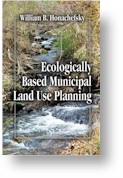  |
|
|
By William Honachefsky [The excerpts below
are from the introductory sections of a thoughtful new book by William
Honachefsky -- Ecologically
Based Municipal Land Use Planning. With every new revelation,
Congress and the states promulgated environmental laws, rules and regulations,
much of it derogatorily described at the time as knee jerk legislation,
in unprecedented proportions. The nation's sense of remorse and guilt
was so deep that massive state and federal bureaucracies were created,
thousands of persons employed, and billions of dollars appropriated
and spent, all in the name of environmental protection. Being
anti-environment was nearly "A
century or more of abuse couldn't be legislated
away or rectified overnight." Unfortunately, we were probably 100 years too late. Much to our chagrin, we found that a century or more of abuse couldn't be legislated away or rectified overnight, in this case, even three decades, and it is now doubtful that some of the environmental / ecological damage we inflicted will ever be fully remedied. So now we talk of acceptable risks and risk assessments -- how many of our neighbors in a hundred thousand or in a million are we willing to sacrifice so that our economy can go on providing the rest of us with all of those things that advertising firms insist we absolutely, positively need. In any event, there is much to be learned from this historical American experiment in human ecology. First, of course, is the need to finally acknowledge that a system of natural ecological infrastructure exists everywhere, that it functions with or without our presence, and that when we interfere with its functions the resulting effects are often cataclysmic, despite our attempts to reconstruct, duplicate or mend it. Therefore, it is in our best long-term interests to keep as much of this natural infrastructure as healthy and as intact as possible. Second, and perhaps the most
important lesson to be learned from this unplanned experiment, is the
fact that we did not fully realize, at least initially, the powerful
influence that municipal land use planning has on the quality of our
natural environment. As a result, local land planners have been "We
did not fully realize, at least initially, the
powerful influence that municipal land use planning
has on the quality of our natural environment." While we may think that federal and state governments have near total control over protection of the environment, we often forget that long before their respective environmental protection agencies sit down to review projects and issue regulatory permits for such wide ranging programs as wetlands protection, point source wastewater discharges to surface waterways, air pollution control, floodplain management and protection of endangered plants and animals, municipal land planners, all across the United States, have been out there, well ahead of them, prescribing, mostly through local zoning ordinances, where residential subdivisions will be placed and at what densities. They will also have already determined where and how factories, commercial and office buildings will be located and how much impervious parking lot and roadway asphalt will be allowed, as well as where their sanitary sewage and stormwater collection systems will be placed and into which waterway they will discharge. They will also have determined what water supplies will be used for all of this development and where the new local roadways to accommodate all of these new landscape changes will be placed. By the time state and federal
regulators show up on the scene to fulfill their obligations to protect
the environment, the character of the resulting landscape will have
already been pretty much determined. It is the character of these developing
landscapes and the resulting impacts, particularly in rural andWe
did not fully realize, at least initially, the
powerful influence that municipal land use planning
has on the quality of our "By
the time state and federal regulators show up
on the scene ... to protect the environment,
the character of the resulting landscape will
have already been pretty much determined." As discussed (previously), local land use planning may be more responsible for the resultant quality of our natural environment than all of the state and federal environmental regulations combined. Despite what now seems such an obvious nexus between local land use and environmental quality, local land planners have had only peripheral involvement in the environmental protection strategies devised by federal and state regulators over the past three decades. That, however, is about to change rather dramatically, as state and federal environmental regulators intensify their efforts to cultivate much closer partnerships with local governments. This is not to imply that
municipal land planners haven't been making some good faith efforts
on their own to incorporate environmental protection into their land
planning considerations. Many municipalities, for instance, have for
decades required the preparation of environmental impact statements
for major land development projects. Some towns have gone even further,
compiling comprehensive inventories of some of the major natural resources
occurring within their jurisdictional boundaries. Others still have
adopted sophisticated stormwater control ordinances, tree protection
ordinances, steep slope ordinances and soil and sediment control ordinances.
Yet, despite all of these laudable efforts, an ecologically incongruous
pattern of land development, now collectively referred to as sprawl, "An
ecologically incongruous pattern of land development,
now collectively referred to as sprawl, continues
to consume more and more of the American landscape." To be sure, local land planners have not had an easy time of it. Decision making during the site plan review process is often a grueling experience with experts on both sides frequently offering diametrically opposed opinions which are further confounded by exhausting discourses on the results of so-called predictive models that some how always seem to predict little or no environmental impact. Yet, as we know, post-construction conditions tell a much different story. Local land planners have been chastised and sanctioned by the courts, who often seem convinced that local planners have a secret agenda, facilitated by large lot zoning, to thwart the migration of low income families into their neighborhoods, not realizing of course, that large lot zoning is often a municipality's last ditch effort to save at least part of its ecological infrastructure intact. And finally, of course, there are the developer's attorneys who, at the slightest suggestion of a density reduction or plan modification to accommodate some environmental concern, threaten to run to the courts to plead for monetary compensation based on a regulatory taking. Add to this the need to accommodate the 120 million more Americans that have joined our ranks since 1950, plus the completion of those development inducing, pollution generating interstate highway systems through previously rural and agricultural areas, and it is little wonder that local land planners often feel overwhelmed. Some even argue that land developers and speculators have more to say over how land in their communities will be used than the local planners or community residents themselves. Local land planners are not entirely guiltless. In fact, they may be partly or wholly responsible for some of the problems they find so vexing. Take, for example, the preparation of a comprehensive Community or Municipal Master Plan (MMP), an acknowledged prerequisite for establishing sensible land use of any kind. Some communities, even at this late date, have yet to prepare much less adopt such a plan, and even where one has actually been crafted, it is often so superficial that it is an MMP in name only. As a consequence, the zoning
ordinance, originally intended to support the day to day implementation
of the recommendations of an MMP, has become the de facto MMP in a majority
of the nation's local communities. While zoning has many valid and useful
purposes, it will never be an adequate substitute for a comprehensive
MMP, and if you need further reinforcement of zoning's shortcomings
in this regard, "The
nation is poised on the threshold of a land planning renaissance." In spite of this rather bleak assessment, there is reason for considerable optimism. Clearly the nation is poised on the threshold of a land planning renaissance that will significantly alter the way in which Americans, and local governments in particular, conduct the business of land use planning. It is for certain that this reformation will include a much greater emphasis on environmental / ecological protection, thanks to the public's indignation over the landscape evolving from the present system of land use and the concerted effort by state and federal environmental regulators to recruit and incorporate local governments into their environmental protection agendas. The mantra of this reformation is simply this: "The quality of our lives is dependent upon the quality of our environment, which is largely dependent upon the quality of our land use." The fact that the quality of our lives is so dependent upon the quality of our natural environment is nothing new. Early American conservationists ... have given us plenty of forewarning in this regard. Likewise for the close relationship between environmental quality and land use, a doctrine eruditely espoused by Aldo Leopold in 1933. Leopold would be pleased to know that the "extension of the social conscience from the people to the land" that he yearned for was about to come to fruition. Published works of a more recent vintage ... continue to demonstrate that there is considerable wisdom in planning our land use around the ecological constraints of the land. Despite all of the compelling evidence and cogent arguments, both recent and historic, favoring the implementation of a more ecologically sensitive approach to land use planning, municipal planners, in general, remain frustratingly wary. It is apparent that it will take considerably more encouragement and education to win over their hearts and minds completely. This book is an attempt to do exactly that. |
|
Home | History & Archive | Video Productions & Services © Copyright 1998-2023 EcoIQ
|













 His
book incorporates the latest research, GIS mapping techniques, and a
host of unique ecological indicators into a new approach to land use
planning. The goal is to broaden the process beyond the considerations
normally involved in zoning. It provides easily understood, nuts and
bolts solutions for controlling urban sprawl, emphasizing the integration
of federal, state, and local policies and plans.]
His
book incorporates the latest research, GIS mapping techniques, and a
host of unique ecological indicators into a new approach to land use
planning. The goal is to broaden the process beyond the considerations
normally involved in zoning. It provides easily understood, nuts and
bolts solutions for controlling urban sprawl, emphasizing the integration
of federal, state, and local policies and plans.]